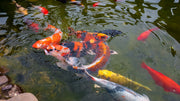
Before we dive in, imagine this: you buy a few palm-sized juveniles in spring, and by the following summer they’re the length of your forearm. You scramble for a bigger net, rethink your filter, and realise koi aren’t just colourful—they’re powerhouses of growth when conditions are right. Understanding their timeline lets you keep pace with upgrades instead of playing catch-up.
Understanding Koi Growth
Koi possess a genetic drive to become true giants, but whether they reach that potential depends on water quality, temperature, stocking density and, critically, the consistency of oxygen-rich circulation. Poposoap’s solar pumps, aerators and waterfall kits excel here: they provide continuous, energy-free flow that keeps dissolved-oxygen high and bio-filters humming—conditions every centimetre of growth demands.
Koi Growth Stages: From Fry to Giant

Koi pass through five broad stages, each with its own speed limits and care priorities:
1. Fry (0–8 weeks, < 2 cm / ¾ in)
Newly hatched koi feed on plankton and powdered fry food. They need warm, stable water (24–26 °C), gentle surface agitation, and secure cover from predators. Growth can hit 1 mm a day in prime conditions.
2. Fingerlings (2–6 months, 2–10 cm / ¾–4 in)
Still delicate but far hungrier, fingerlings thrive on 40 %-protein crumbles offered four to six times daily. Warm temperatures plus high oxygen are critical; trickling returns from a small Poposoap solar pond filter keep currents soft yet fresh.
3. Yearlings (6–18 months, 10–25 cm / 4–10 in)
Bone structure strengthens and body depth develops. They benefit from spacious ponds (at least 1,000 L / 250 gal) and continuous turnover. Expect growth spurts of 12–15 cm (5–6 in) during their first full summer.
4. Sub-adults (18–36 months, 25–45 cm / 10–18 in)
Appetite steadies; muscle fills out. Protein can taper to 35 %, and mineral balance (especially calcium and carbonate hardness) becomes vital for scale quality. Depths of 90 cm+ let them exercise and thermoregulate.
5. Adults & Jumbos (3 years+, 45 cm / 18 in up to 1 m / 40 in)
Growth slows to a few centimetres a year, shifting toward girth. Only low stocking (1 kg per 100 L) and pristine, highly-oxygenated water let genetics push past the 80 cm (32 in) mark. Robust Poposoap 30–55 W solar pond filters circulating 320–580 GPH keep ammonia and nitrite near zero while adding no grid cost.
With optimal care, a quality Japanese-lineage koi can add 25 cm (10 in) in its first year and another 15–20 cm the second—answering, for many, the headline question of how fast do koi fish grow.
What Affects the Growth Rate of Koi?

- Genetics – Jumbo parents breed bigger offspring.
- Temperature – 22–28 °C (72–82 °F) fuels enzyme efficiency; too cool or too hot slows conversion.
- Nutrition – 35–40 % protein for juveniles; balanced amino acids and carotenoids deepen colour as well as length.
- Water Quality – Ammonia < 0.1 ppm, nitrite 0, nitrate < 40 ppm, KH > 80 ppm. Poposoap filter boxes packed with foams, bio-balls and optional UV keep parameters tight. Poposoap Product Manual…
- Oxygen & Flow – ≥ 6 mg L-¹. Floating solar fountains or spillway kits create the surface agitation koi gills crave.
- Stocking Density – Crowding diverts calories to stress rather than length.
Tips to Help Your Koi Grow Bigger, Faster

- Feed to water temperature—four small meals at 24 °C, two at 18 °C; nothing below 10 °C.
- Use energy-efficient, 24/7 filtration. A Poposoap 30 W solar unit circulates 320 GPH without grid heat load, letting bacteria polish water day and night.
- Supplement aeration during heat waves with a Poposoap floating aerator positioned in the deepest zone.
- Provide depth and swimming room. Minimum 90 cm (3 ft); 120 cm (4 ft) for jumbo potential.
- Over-winter correctly. Maintain a small, aerated opening; cease high-protein feed under 10 °C.
- Quarantine new fish—external parasites or bacteria can stunt the whole pond.
Common Myths About Koi Growth

- “Koi only grow as large as the pond allows.” They’ll keep growing internally, leading to stunting-related health issues if space is insufficient.
- “High protein year-round guarantees giant size.” Excess protein in cool water ferments and stresses kidneys.
- “Fast growth ruins pigment.” Poor water, not speed, dulls colour. Balanced diets plus clean, oxygen-rich water deepen reds and sumi.
- “UV sterilizers stunt koi.” UV only targets free-floating algae and pathogens, not nutrients or trace minerals required for growth.
Conclusion: Patience Pays Off
So how long does it take for koi fish to grow to show size? Expect meteoric gains the first two years, solid development through year five, and gradual thickening into adulthood. Match prime genetics with warm, clean, well-oxygenated water—easiest with Poposoap’s solar-powered pumps, filters and aerators—and the fish will do the rest. Growth in koi isn’t a race won by shortcuts; it’s a marathon of steady, informed husbandry. Provide the right environment, wait, and watch: patience, paired with smart technology, is the surest path from speckled fry to pond monarch.










